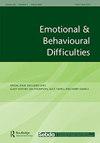The experience of panic attacks in adolescents: an interpretative phenomenological analysis study
IF 1.5
Q3 PSYCHOLOGY, EDUCATIONAL
引用次数: 3
Abstract
ABSTRACT Panic attacks are common in adolescents and are experienced in several mental health difficulties. In adults, cognitions during panic attacks comprise mental images as well as thoughts. No qualitative research into panic attacks has been conducted with adolescents. Better understanding of the experience of panic attacks, including the presence and nature of mental images, may improve treatments. Nine adolescents (15–18 years) completed a semi-structured interview exploring experiences of panic attacks. Data was analysed using Interpretative Phenomenological Analysis. Six superordinate themes reflected the intense nature of having a panic attack, being unable to think and fearing losing control of one’s mind, a disconnect in feeling the panic attack would never end versus knowing from experience that it would, feeling completely out of control during the attack, feeling embarrassment and shame, feeling cut-off and isolated from others, and trying to find ways to cope through distraction, avoidance and learning to understand the thoughts. Mental images enhanced the intensity of panic. Several aspects of the findings were consistent with the cognitive model of panic disorder in adults. The impact of panic on normative adolescent developmental tasks is discussed. Interventions should be adapted for adolescents’ developmental stage and consider any mental images.青少年惊恐发作的经验:解释性现象学分析研究
惊恐发作在青少年中很常见,并且在许多心理健康问题中都有经历。在成人中,惊恐发作期间的认知包括心理图像和思想。目前还没有针对青少年恐慌发作的定性研究。更好地了解恐慌发作的经历,包括心理图像的存在和性质,可能会改善治疗。9名青少年(15-18岁)完成了一项半结构化的访谈,探讨了恐慌发作的经历。数据分析采用解释性现象学分析。六个高级主题反映了恐慌发作的强烈性质,无法思考,害怕失去对自己思想的控制,感觉恐慌发作永远不会结束的感觉与从经验中知道它会结束的感觉脱节,在发作期间感觉完全失控,感到尴尬和羞耻,感觉被他人切断和孤立,并试图通过分心,回避和学习来找到应对的方法理解这些想法。脑海中的画面增强了恐慌的强度。研究结果的几个方面与成人惊恐障碍的认知模型一致。讨论了恐慌对青少年规范性发展任务的影响。干预措施应适应青少年的发展阶段,并考虑到任何心理图像。
本文章由计算机程序翻译,如有差异,请以英文原文为准。
求助全文
约1分钟内获得全文
求助全文
来源期刊

EMOTIONAL AND BEHAVIOURAL DIFFICULTIES
PSYCHOLOGY, EDUCATIONAL-
CiteScore
1.80
自引率
10.00%
发文量
10
期刊介绍:
The central intention of Emotional & Behavioural Difficulties (EBDs) is to contribute to readers" understanding of social, emotional and behavioural difficulties, and also their knowledge of appropriate ways of preventing and responding to EBDs, in terms of intervention and policy. The journal aims to cater for a wide audience, in response to the diverse nature of the professionals who work with and for children with EBDs.
 求助内容:
求助内容: 应助结果提醒方式:
应助结果提醒方式:


